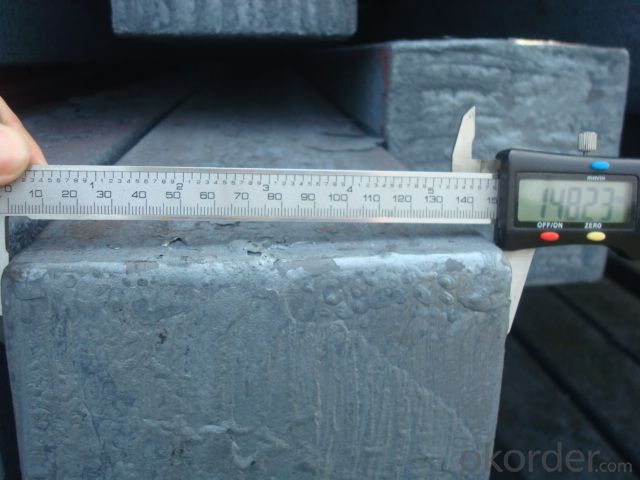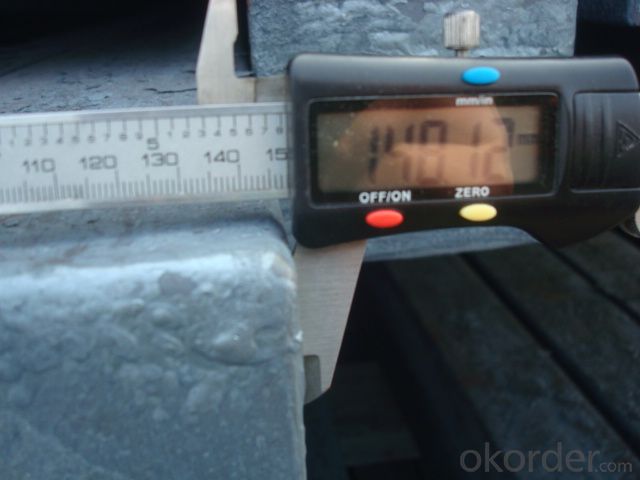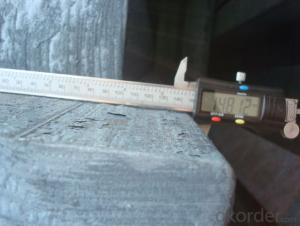Hot Sale Q275/5SP Square Steel Billets 50mm-180mm
- Loading Port:
- Tianjin
- Payment Terms:
- TT OR LC
- Min Order Qty:
- 1000 m.t.
- Supply Capability:
- 30000 m.t./month
OKorder Service Pledge
OKorder Financial Service
You Might Also Like
STEEL BILLET
1.Brief description
Steel billet(ingot) by cogging or breakdown of semi-finished products, is the raw material of all kinds of steel mill. Billet section of square, round, flat, rectangular and abnormity of several kinds of, mainly related to the shape of rolled products.
2.Features
Rectangular billet continuous casting billet and mainly general carbon steel, low carbon low silicon cold-rolled material, high quality carbon structural steel, high strength low alloy steel, special steel, etc.
The billet is mainly divided into two kinds from the shape:
Slab: cross section width and height of the ratio of the larger, mainly used for rolling plate.
Billet: equal cross section width and height, or a huge difference, mainly used for rolling steel, wire rod. ,
Steel billets have distinct characteristics as compared with already furnished steel bars and products. Billets have a specific grain structure, which enables the metal to be processed more intricately. Steel billets are also known for their malleability and ductility, especially when exposed to varying temperatures during shaping and molding.
3.Processing
Steel billets are considered fresh and raw, and they must undergo a series of manufacturing processes before they can be used for various purposes. Billets are made by means of freezing molten liquid, and are later exposed to extremely low temperatures in order to allow the metal to take shape and solidify in chemical structure. The temperature manipulates the metal's physical properties, and tones its strength and durability. The subsequent processes provide the metal's curved mold design so that it can fit the allotted space provided by other machines, which complete the finishing procedures.
4.Pictures


5.Usage
Billets, or ingots (as they sometimes referred to), are not of practical use until they have been formed into more functional shapes and sizes. While they have already been put in the furnace, they still require a series of shaping and molding procedures such as hot and cold working, milling and cutting before they are sold in hardware stores, or used for different applications. The unformed billets, however, can be used in striking currency such as coins and as reserves, similar to gold bars.
6.Detailed specification
Hot rolled billet steel
Size: 50x50mm-180x180mm
Steel Grade: 3SP, 5SP,Q195,Q235,Q255,Q275 Length:3m-12m
MOQ: 1000MT/size
Payment term: TT or LC
Packing: in bulk , bundle
Shipment: by container , bulk vessel
Packaging Details: bundles with steel strips or as customers's requirements
Delivery time: 15-30 days after the deposit
Loading port:Tianjin, or other port China
Origin : China
Inspection:Third party inspection before loading.
- Q:20 what is the difference between manganese silicon steel billet and Q235 billet?
- In brief, the ingredients are different and the uses are different.
- Q:What is the difference between steel and billet in the process?
- Square is a square steel hollow, with iron produced; but it is a square steel billet is generally solid, forging or casting molding.
- Q:What are the main differences between hot-rolled and cold-rolled steel billets?
- The main differences between hot-rolled and cold-rolled steel billets lie in the manufacturing process and the resulting characteristics of the steel. Hot-rolled steel billets are produced at high temperatures, resulting in a rougher surface and less precise dimensions. They are more malleable and ductile, making them suitable for applications that require shaping or bending. On the other hand, cold-rolled steel billets are manufactured at room temperature, resulting in a smoother and more precise surface finish with tighter dimensional tolerances. Cold-rolled steel billets are stronger and exhibit better surface hardness, making them ideal for applications that require strength, precision, and a superior surface finish.
- Q:How do steel billets contribute to the overall corrosion protection of a structure?
- Steel billets contribute to the overall corrosion protection of a structure by being manufactured with specific chemical compositions and surface finishes that enhance their resistance to corrosion. These billets are used to produce corrosion-resistant steel products, such as beams, columns, and plates, which are then incorporated into the structure. The corrosion resistance of these steel products helps to prevent the formation and spread of rust, ensuring the longevity and durability of the structure.
- Q:Are there any international standards for steel billets?
- Indeed, steel billets are subject to international standards. The International Organization for Standardization (ISO) has formulated multiple standards that outline the prerequisites and specifications for steel billets. ISO 683-2 stands out as the most widely utilized ISO standard for steel billets, as it delineates the technical delivery requirements for hot-rolled steel bars, sections, and billets intended for general engineering applications. Moreover, the American Society for Testing and Materials (ASTM) has also established its own set of standards for steel billets, exemplified by ASTM A615/A615M. This particular standard specifies the criteria for deformed and plain carbon-steel bars designed for concrete reinforcement. These global standards ensure that steel billets, produced and traded worldwide, fulfill the essential quality and performance criteria, thereby fostering uniformity and compatibility within the industry.
- Q:How does the composition of steel affect the properties of steel billets?
- The composition of steel, including the ratios of different elements and the impurities present, significantly influences the properties of steel billets. For instance, the amount of carbon in steel affects its strength and hardness, with higher carbon content resulting in harder and stronger steel. Alloying elements like chromium, nickel, and molybdenum can be added to enhance specific properties such as corrosion resistance, heat resistance, or toughness. Furthermore, impurities like sulfur and phosphorus can negatively impact the ductility and weldability of steel. Hence, the composition plays a crucial role in determining the overall quality and performance of steel billets.
- Q:How are steel billets inspected for surface defects?
- Steel billets are inspected for surface defects through visual inspection, magnetic particle inspection, and ultrasonic testing. Visual inspection involves a thorough examination of the surface for any visible defects such as cracks, pits, or rough spots. Magnetic particle inspection uses magnetic particles and a magnetic field to identify any surface or near-surface defects that may not be visible to the naked eye. Ultrasonic testing utilizes high-frequency sound waves to identify internal and surface defects by analyzing the reflected waves. These inspection methods ensure the quality and integrity of steel billets before further processing.
- Q:What are the different types of steel used for manufacturing billets?
- Manufacturing billets commonly employ various types of steel, each possessing unique properties and applications. Some frequently utilized steel types for this purpose encompass: 1. Mild Steel: Widely employed for billet manufacturing, mild steel exhibits low carbon content and is renowned for its strength and ductility. It suits general-purpose applications that do not necessitate high strength. 2. Carbon Steel: Containing higher carbon levels than mild steel, carbon steel offers enhanced hardness and strength. Hence, it is suitable for wear-resistant applications like tools and machinery components. 3. Alloy Steel: Alloy steel is produced by incorporating diverse alloying elements, including manganese, nickel, chromium, or molybdenum, into the base iron. Consequently, it exhibits augmented strength, durability, and corrosion resistance. The automotive, aerospace, and construction industries typically employ alloy steel billets. 4. Stainless Steel: Stainless steel is an alloy comprising at least 10.5% chromium, which endows it with remarkable resistance against corrosion and staining. Consequently, it is ideal for applications requiring high hygiene levels, such as food processing equipment and medical devices. 5. Tool Steel: Tool steel, a high-carbon steel, is specifically engineered for tool, die, and mold production. It is renowned for its hardness, wear resistance, and ability to retain shape at elevated temperatures. 6. High-Speed Steel: This type of tool steel is designed to endure high temperatures without compromising its hardness. It is frequently employed for cutting tools like drills and milling cutters. These examples merely represent a fraction of the steel types utilized for billet manufacturing. The selection of steel hinges upon specific requirements, such as strength, durability, corrosion resistance, and temperature resistance, dictated by the application at hand.
- Q:How do steel billets contribute to the manufacturing of electrical appliances?
- Steel billets play a vital role in the manufacturing of electrical appliances by providing a strong and durable material for various components. Electrical appliances, such as refrigerators, washing machines, and air conditioners, require sturdy structures to withstand constant usage and external forces. Steel billets, which are semi-finished metal products, are used as a raw material in the manufacturing process to create these robust structures. Firstly, steel billets are forged or rolled into different shapes and sizes to create the frames, chassis, and housing of electrical appliances. These components provide the necessary support and protection for the internal parts of the appliances. The strength and stability of steel make it an ideal choice for withstanding the weight and vibrations generated during the operation of electrical appliances. Additionally, steel billets are used to fabricate the motor cores and transformer cores in electrical appliances. Motor cores are essential for converting electrical energy into mechanical energy, while transformer cores are responsible for regulating the voltage in electrical circuits. Steel's magnetic properties, such as high electrical conductivity and low hysteresis loss, make it an excellent choice for these applications, ensuring efficient energy conversion and transmission. Moreover, steel billets are utilized to manufacture heating elements and electrical contacts in appliances like stoves, ovens, and switches. These components require materials that can withstand high temperatures, resist corrosion, and provide excellent electrical conductivity. Steel billets are often alloyed with other metals, such as nickel or chromium, to enhance these properties, making them highly suitable for such applications. In conclusion, steel billets contribute significantly to the manufacturing of electrical appliances by providing a durable and versatile material for various components. The strength, stability, and magnetic properties of steel make it an essential raw material for creating the frames, motor cores, transformer cores, heating elements, and electrical contacts used in these appliances. Thanks to steel billets, electrical appliances can perform reliably and efficiently, meeting the needs and expectations of consumers.
- Q:What are the applications of steel billets in the automotive industry?
- Steel billets are an essential component in the automotive industry, playing a crucial role in various applications. One of the primary uses of steel billets in this industry is for the production of engine parts. The billets are forged and machined to create crankshafts, connecting rods, and camshafts, which are vital components for the proper functioning of an engine. Steel billets are also used in the manufacturing of suspension and steering components. These billets are shaped into various parts such as control arms, tie rods, and steering knuckles, which provide stability, control, and smooth handling to the vehicle. These components are crucial for ensuring a safe and comfortable driving experience. Furthermore, steel billets find applications in the production of transmission components. They are forged and machined to create gears, shafts, and other transmission parts that facilitate the smooth transfer of power from the engine to the wheels. These components play a significant role in the overall performance and efficiency of the vehicle. Additionally, steel billets are used in the manufacturing of chassis and frame components. By using billets, manufacturers can create strong and durable structures that provide stability and support to the entire vehicle. Chassis components such as cross members, brackets, and reinforcements are often made from steel billets to ensure the vehicle's structural integrity. In summary, steel billets are widely employed in the automotive industry for various applications. They are used to create engine parts, suspension and steering components, transmission parts, and chassis components. The use of steel billets in these applications ensures the durability, performance, and safety of vehicles.
1. Manufacturer Overview |
|
|---|---|
| Location | |
| Year Established | |
| Annual Output Value | |
| Main Markets | |
| Company Certifications | |
2. Manufacturer Certificates |
|
|---|---|
| a) Certification Name | |
| Range | |
| Reference | |
| Validity Period | |
3. Manufacturer Capability |
|
|---|---|
| a)Trade Capacity | |
| Nearest Port | |
| Export Percentage | |
| No.of Employees in Trade Department | |
| Language Spoken: | |
| b)Factory Information | |
| Factory Size: | |
| No. of Production Lines | |
| Contract Manufacturing | |
| Product Price Range | |
Send your message to us
Hot Sale Q275/5SP Square Steel Billets 50mm-180mm
- Loading Port:
- Tianjin
- Payment Terms:
- TT OR LC
- Min Order Qty:
- 1000 m.t.
- Supply Capability:
- 30000 m.t./month
OKorder Service Pledge
OKorder Financial Service
Similar products
New products
Hot products
Related keywords






























